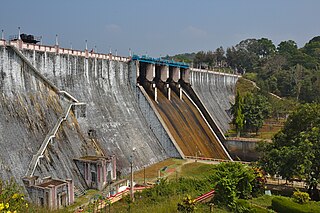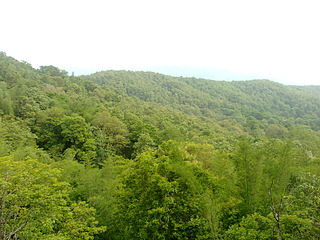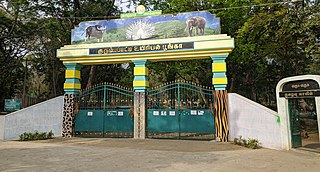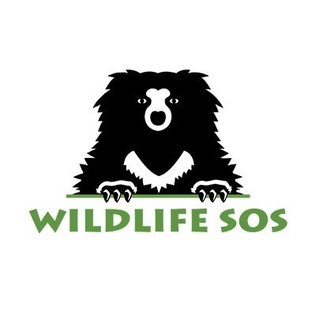
Idukki is one of the 14 districts in the Indian state of Kerala in the southwest of the country. It is the largest district in Kerala and lies amid the Cardamom Hills of Western Ghats in Kerala. Idukki district contains two municipal towns – Kattappana and Thodupuzha, and five taluks.

Elephants found in Kerala, the Indian elephants, are one of three recognized subspecies of the Asian elephant. Since 1986, Asian elephants have been listed as endangered by IUCN as the population has declined by at least 50% over the last three generations, estimated to be 25,600 to 32,750 in the wild. The species is pre-eminently threatened by habitat loss, degradation and fragmentation. Along with a large population of wild elephants, Kerala has more than seven hundred captive elephants. Most of them are owned by temples and individuals. They are used for religious ceremonies in and around the temples, and some churches, and a few elephants work at timber yards.

Wayanad Wildlife Sanctuary is a wildlife sanctuary in Wayanad, Kerala, India with an extent of 344.44 km2 (132.99 sq mi) and four hill ranges namely Sulthan Bathery, Muthanga, Kurichiat and Tholpetty. A variety of large wild animals such as gaur, Indian elephant, deer and Bengal tiger are found there. There are also quite a few unusual birds in the sanctuary. In particular, Indian peafowl tend to be very common in the area. Wayanad Wildlife Sanctuary is the second largest wildlife sanctuary in Kerala. It is bestowed with lush green forests and rich wildlife. This wildlife area houses some of the rare and endangered species of both flora and fauna.

Neyyar dam is a gravity dam on the Neyyar River in Thiruvananthapuram district of Kerala, South India, located on the foot of the Western Ghats about 30 km from Thiruvananthapuram. It was established in 1958 and is a popular picnic spot.
The Neyyar Wildlife Sanctuary in the southern state of Kerala in India is spread over the southeast corner of the Western Ghats, and covers a total area of 128 km2 (49 sq mi). It is located between 77° 8’ to 77° 17’ east longitude and 8° 29’ to 8° 37’ north latitude, central location 8°33′N77°12.5′E. Although it was declared as a sanctuary in 1958, not much was done about wildlife conservation, until 1985, when a separate wildlife wing was set up and as a result, conservation efforts have gathered momentum. It is part of the Agasthyamala Biosphere Reserve.
Bio reserved of india full map of india

Parambikulam Tiger Reserve, which also includes the erstwhile Parambikulam Wildlife Sanctuary, is a 643.66 square kilometres (248.5 sq mi) protected area lying in Palakkad district and Thrissur district of Kerala state, South India. The Wildlife Sanctuary, which had an area of 285 square kilometres (110 sq mi) was established in part in 1973 and 1984. It is in the Sungam range of hills between the Anaimalai Hills and Nelliampathy Hills. Parambikulam Wildlife Sanctuary was declared as part of the Parambikulam Tiger Reserve on 19 February 2010. Including the buffer zone, the tiger reserve has a span of 643.66 km2. The Western Ghats, Anamalai Sub-Cluster, including all of Parambikulam Wildlife Sanctuary, has been declared by the UNESCO World Heritage Committee as a World Heritage Site. The Tiger Reserve is the home of four different tribes of indigenous peoples including the Kadar, Malasar tribe, Muduvar and Mala Malasar settled in six colonies. Parambikulam Tiger Reserve implements the Project Tiger scheme along with various other programs of the Government of India and the Government of Kerala. The operational aspects of administering a tiger reserve is as per the scheme laid down by the National Tiger Conservation Authority. People from tribal colonies inside the reserve are engaged as guides for treks and safaris, and are provided employment through various eco-tourism initiatives. Parambikulam Tiger Reserve is among the top-ten best managed Tiger Reserve in India. The tiger reserve hosts many capacity building training programmes conducted by Parambikulam Tiger Conservation Foundation in association with various organisations.
Vellarada is a border village situated in Thiruvananthapuram district in the state of Kerala, India. It is 42 km from Thiruvananthapuram. It is the southernmost part of Kerala state, sharing its border with Tamil Nadu. Vellarada is said to be the threshold to the high-range areas of the eastern part of Thiruvananthapuram district. The southernmost point of Western Ghats in Kerala is near Vellarada.

Mela shikar is a traditional method of capturing wild elephants for captive use. These methods get employed in Burma, Thailand, Vietnam, Laos and Cambodia and in Assam in India. The process involves lassoing a wild elephant from the back of a trained one, called a koonki. This practice is prevalent in the northeastern part of India, especially in Assam, and is one of the methods seen in ancient India. Other traditional elephant capture methods include: khedda, byle shikar, snaring, pit method, and decoying by using a female koonki to lure a male elephant. Mela shikar used to be organized twice a year – after Durga Puja and during Bihu.
Agasthyavanam Biological Park is a protected area in the Western Ghats in Kerala State, India. The park is located within Vazhichal Panchiyat and lies between the Neyyar and Peppara Wildlife Sanctuaries which covers an area of about 31 square kilometres (12 sq mi).
State Highway 3 is a State Highway in Kerala, India that starts at Nedumangad Toll junction and ends at the Kadukkara near Kerala - Tamilnadu border. The highway is 37.5 km long. This was part of hitherto existed Aralvaimozhi - Nedumangad royal state highway of Travancore. Now a part of it is in Kerala and another in Tamilnadu. The road runs parallel to Western Ghats till the Aralvaimozhi pass.
The Crocodile Rehabilitation and Research Centre is a crocodile breeding and rearing park situated at Neyyar, a popular tourist destination near the city of Thiruvananthapuram in Kerala, India.
Kuttichal is a village in Thiruvananthapuram district in the state of Kerala, India. The Kuttichal panchayath has borders with Aryanad, Poovachal, Kallikkad, panchayaths and Thiruneveli District of Tamil Nadu India. Kuttichal is part of Kattakada Taluk, Vellanad block panchayath and Aruvikkara Legislative Assembly. Kuttichal also has the kottor Elephant rehabilitation centre which is famous among tourists.

Konni Aanakkoodu located in Konni is a well known training center for elephant's in Kerala. Its at a distance of 11 km from Pathanamthitta town.

The Kurumbapatti Zoological Park is a second largest zoo in Tamil Nadu next to Arignar Anna Zoological Park, situated in the foothills of the Shervaroyan Hills, 10 km from Salem, Tamil Nadu, India. It was set up in 1981 as a small museum and was later extended to 69 Ha. The zoo houses many species of wildlife, with monkeys as the major attraction, and is in the vicinity of reserve forest, permitting visitors the opportunity to also experience the flora and fauna there. The park has a gentle topography, areas of bamboo and woodland and semi-perennial streams. Facilities include a children's playground area.

Wildlife SOS (WSOS) is a conservation non-profit organisation in India, established in 1995 with the primary objective of rescuing and rehabilitating wildlife in distress, and preserving India's natural heritage. It is currently one of the largest wildlife organisations in South Asia.

Sangita Iyer is an Indian-born Canadian author, broadcast journalist, writer, biologist and documentary filmmaker. She is known for her advocacy on wildlife conservation, especially for wild elephants, and for exposing the atrocities against Asian elephants by religious institutions. She is the founding executive director and president of the Voice for Asian Elephants Society, which was created in 2016 with the aim of protecting wild and captive elephants of India.

Kottoor Soman, also known as Konniyil Soman and Kottur Soman, is an Indian elephant and retired kumki who was inaccurately claimed or represented in 2020 to be the oldest living elephant in the world, owned by the Kerala Forest Department, but the claim of birth year has not been confirmed, which is why his submission into Guinness Book of Records was rejected.

Abhayaranyam is an animal shelter–mini zoo, which functions under the eco-tourism project of Kerala government. Located near to Kaprikad village in Kunnathunad taluk of Ernakulam district, the shelter was opened in 2011, with an aim to rehabilitate the animals in the Kodanad elephant training center, located two kilometers away. Kodanad Elephant training center was one of renowned and largest elephant training center in Kerala. It was also the first elephant training center in Kerala, started in 1895. The center covered an area of 2 acres and when the number of animals there kept increasing, all the animals were gradually relocated to Abhayaranyam, which has an area of 123 hectares.

Events in the year 2024 in Kerala.













